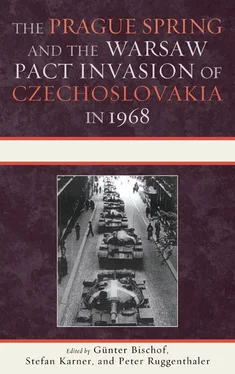61. MOL, M-KS-288, F. 47/743 (cf. note 58).
62. MOL, M-KS-288, F. 4/93, minutes of the meeting of the HSWP CC, 7 August 1968; Huszár, 1968, Prága, Budapest, Moszkva , 163.
63. Navrátil et al., Prague Spring , 218, 220–21. Kádár’s entire speech is reprinted in Karner et al., Dokumente , #77.
64. This threat could in no way be regarded as a merely theoretical possibility as indeed, there had been such a precedent not so long ago. Following the failed Hungarian Revolution in 1956, at the Communist summit on 1–4 January 1957 in Budapest, the Soviet, Czechoslovak, Bulgarian, and Romanian leaders forced the Hungarian party to make serious concessions concerning the political development of the country, including vetoing the introduction of a limited pseudo-multiparty system akin to the Czechoslovak model. The same forum also decided on the initiation of a court procedure against members of the Imre Nagy group. Békés et al., The 1956 Hungarian Revolution , 485–95.
65. Navrátil et al., Prague Spring , 229.
66. Navrátil et al., Prague Spring , 216; MOL, M-KS-288, F. 5/462, minutes of the meeting of the HSWP Politburo, 15 July 1968.
67. Huszár, 1968, Prága, Budapest, Moszkva , 228.
68. MOL, M-KS-288, F. 5/467, minutes of the meeting of the HSWP Politburo, 20 August 1968.
69. MOL, M-KS-288, F. 5/467, minutes of the meeting of the HSWP Politburo.
70. MOL, M-KS-288, F. 5/467, minutes of the meeting of the HSWP Politburo.
71. For details of the negotiations of the “Warsaw Five” between 24 and 26 August 1968, see Navrátil et al., Prague Spring , 474–76; MOL, M-KS-288, F. 4/95, minutes of the meeting on 27 August 1968; Huszár, 1968, Prága, Budapest, Moszkva , 272–74.
17
Tito, the Bloc-Free Movement, and the Prague Spring
Tvrtko Jakovina
In the U.S. National Intelligence Estimate on Tito’s Yugoslavia written in April 1967, all U.S. intelligence organizations concluded that Yugoslavia “is a Communist state in name and theory, but in practice it is a fully independent country which has rejected most of the ‘Socialist’ experience of other states, including the USSR and which is deliberately removing its economy from centralized controls and freeing its people from arbitrary authority.” 1In the foreign psolicy domain, the Yugoslav goal was to retain independence at any cost. The Socialist Federal Republic of Yugoslavia ( Socijalistička Federativna Republika Jugoslavija or SFRY) was a “model of nonaligned socialist enterprise” achieving goals by “shrewd compromise” and “clever improvisation.” Although still a defender of the Communist creed, Josip Broz Tito, the undisputed leader of Yugoslavia since 1945, became a model for nationalistic Communists who seemed to be appearing in different quarters of the world. The Yugoslav economy was socialist, to be sure. However, in 1965 reforms and decentralization, the lessening of central control in the decisionmaking process, was taking Yugoslavia toward “market socialism.” The Soviet Union was Yugoslavia’s largest single trade partner, but the country stayed free from dependence on the Lager . The SFRY’s foreign trade share with Western and nonaligned countries was 68 percent. 2Nevertheless, the U.S. estimate was probably too rosy. Yugoslavia was full of problems. Ups and downs are a constant feature of any country’s development, but Tito had “[o]ver the years… responded to this debate with revisions and reforms designed to satisfy at least some of the people some of the time.” 3Yugoslavia, with its many disparate elements and ethnic groups was interesting and dynamic, but far from the best example to emulate. However, Yugoslav achievements in some fields were very attractive. Some in the Third World and those in the Socialist world who were eager to become more independent, could, nevertheless, find Belgrade leadership inspirational. If such was the impression of the brightest experts in the U.S. intelligence community, why deny that there was a certain appeal for the Socialist leaders squeezed by the Soviets? Ever since the break with Joseph Stalin in 1948, Yugoslavia had been closely observed by the Lager countries. Some were envious, some scared by the heretical socialism supported by the West, but a few Socialist leaders concentrated on the autonomy the Yugoslavs were enjoying. Yet deep-seated political and economic problems did not evaporate after the split with the Soviets, despite positive U.S. estimates to the contrary. 4
Both Yugoslavia and Czechoslovakia were founded after World War I and had enjoyed friendly relations ever since. For a few months during 1912, Tito had worked in Čenkov, a town in the central part of Bohemia. His visit to Prague in 1965 was historic for many reasons. It had been almost two decades since Tito’s previous visit to Czechoslovakia. Comrade Antonín Novotný was Tito’s host in Prague, Alexander Dubček in Bratislava. 5In Čenkov, Tito gave a speech in which he praised the Socialist system and his comrade, also a former metal worker, Novotný, “You are happy today just like our people, our working man, are happy. Since they are themselves governing factories, land, and everything they need.” 6Before World War II, Czechoslovakia was much more sophisticated and developed than Yugoslavia. But now Belgrade was constantly experimenting, trying to overcome economic weaknesses, national antagonisms, and political factionalisms, developing quickly and successfully. 7Czechoslovakia and Yugoslavia were both complex countries, and similarities between them abounded. In 1966, Slovak linguists in Smolenice had a conference on “Theses Concerning Slovak” that stressed the representational function of the language. In March 1967, the Declaration on the Name and Position of the Croatian Literary Language was signed in Zagreb by many intellectuals, including members of the Communist Party and some members of the Central Committee. 8Intellectuals in Czechoslovakia were becoming more and more vocal in criticizing the Communist Party of Czechoslovakia’s ( Komunistická strana Č eskoslovenska or KSČ) leader Antonín Novotný. The Yugoslav reforms that began in the mid 1960s gained momentum, especially after the deposition of Alexander Ranković, the strongest Serbian politician in the postwar Yugoslavia. Head of the secret police and minister of the interior and, after Tito, the strongest politician in the party hierarchy, Ranković was deposed as a symbol of the conservative, unitarist forces. Sometimes those forces were using him, sometimes hiding behind him. Although he was not aligned against Tito personally, Ranković became the main obstacle to modernization and reforms. Since his power base was primarily Serbian, he by default antagonized other nationalities. 9After 1966 and his replacement, constraints in Yugoslavia were lessened and liberal changes speeded up in different parts of the SFRY. For example in Mostar, the capital of Herzegovina, an advisory party meeting was held at which secret police measures taken against the population were condemned and the belief that Herzegovians ought to be much more included in the party and state positions in Bosnia and Herzegovina advanced. 10Reform of the economy, issues between different nationalities, and international position (that is, independence) were the most obvious topics connecting Yugoslavia and Czechoslovakia. 11
At the plenary session of the Central Committee (CC) of the KSČ in late 1967, Alexander Dubček asked for the democratization of inter-party relations. He also called for a new party program. 12In January 1968, Novotný was replaced as the first secretary of the KSČ by “our Sasha,” as an initially happy KGB was calling Dubček. 13Things started to change rapidly. During Tito’s week-long visit to Czechoslovakia in 1965, politicians who had accompanied the Yugoslav leader during his brief visit to Bratislava reported how his host, Sasha Dubček, was radiating pleasure. Judging from future developments, he had sincerely admired Tito and was not just being polite. For Moscow, even the remote possibility of being inspired by the Yugoslavs was scary.
Читать дальше












